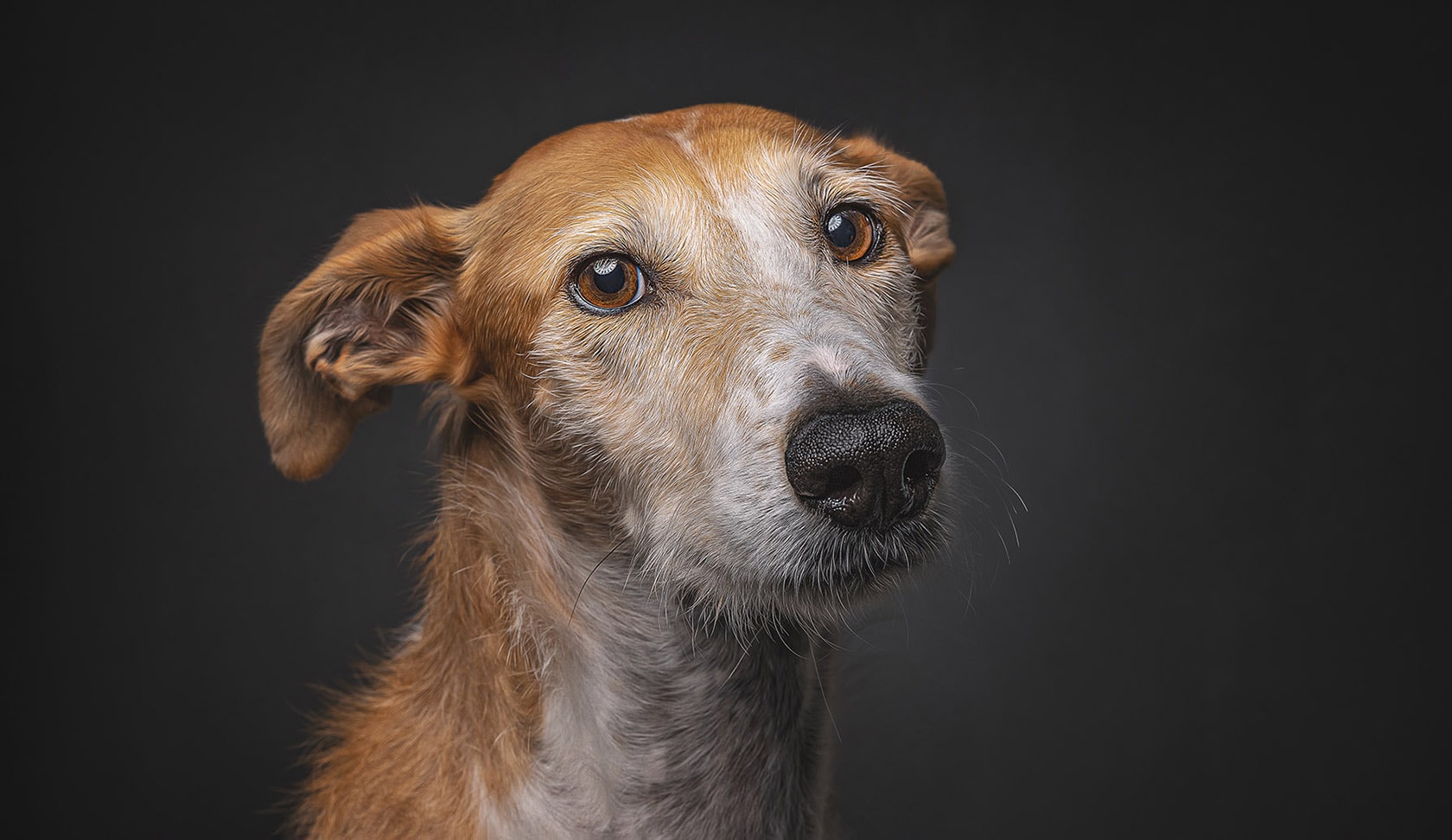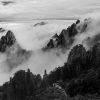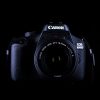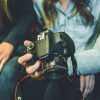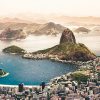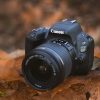Travis Patenaude, the creative genius behind Stink-Eye Photography, has a story that’s as captivating as his photographs. From personal challenges to international acclaim, Travis’s narrative showcases the transformative power of passion and purpose. His bond with a Spanish Greyhound named Leena not only saved his life but also ignited a fervor to advocate for the hunting dogs of Spain.
Through his lens, Travis doesn’t just capture images; he tells stories, evokes emotions, and champions a cause. In this interview, we explore the heart of his work, the inspirations behind his iconic style, and the profound impact of a single dog on a man’s destiny.
Travis Patenaude website: https://www.stinkeyephotography.com
Facebook – StinkEyePhotography
Instagram – @stinkeye_photography
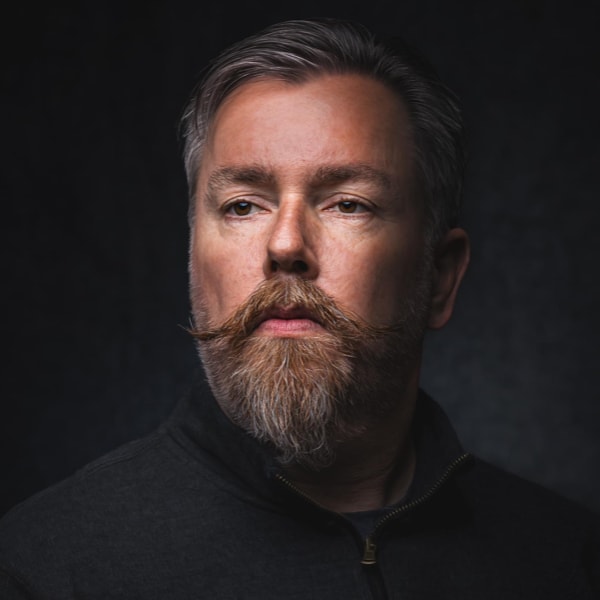
A Lifesaving Connection
Travis, your work at Stink-Eye Photography has garnered international acclaim. What initially drew you to dog photography, and how did you develop your distinctive style? Can you say a few words about Leena?
In October of 2012, I was dealing with a very dark depression and came very close to hanging myself in my garage. I luckily, realized what was happening and was able to stop myself. A week later my wife and I adopted a very scared Spanish Greyhound whose owner was going to hang her in a tree because she was no longer useful to him. The irony was not lost on me.
We spent months working with her to help her learn to trust people again, and because of this, I forgot about my depression. She literally saved my life.
We learned more about Leena’s’ life in Spain and wanted to help, so we started an adoption group for Galgos here in Chicago. We have never been to Spain, did not know anyone in Spain and could not speak Spanish, but we were determined to help.
After our first transport of four dogs from Spain, we had to promote the dogs for adoption which required taking photos of them. My adoptions photos were not very good at that time. We were lucky to have a professional photographer from HeartsSpeak.org come out and take photos of our adoptable dogs. After seeing her images, I knew I had to figure out how to take better photos. I started watching YouTube videos and purchasing several videos. I set a goal to pay it forward and become a member of HeartsSpeak.org and offer photos to dogs looking for their forever homes. One year later, I was able to become a proud member of HeartsSpeak.org
When I started to learn studio lighting, I was following Chris Knight and really loved the low-key cinematic portraits he created. My first conceptual image was created (The Hunter and the Hunted) after watching his class The Dramatic Portrait. A little while later, I came across Tim Flack’s Endangered Book. I was captivated by the portraits in the book and how they depicted animal subjects with human-like personalities. This sparked my curiosity, and upon returning home, I researched more about Tim Flach and his approach to using imagery to elicit emotions and foster empathy towards animals.
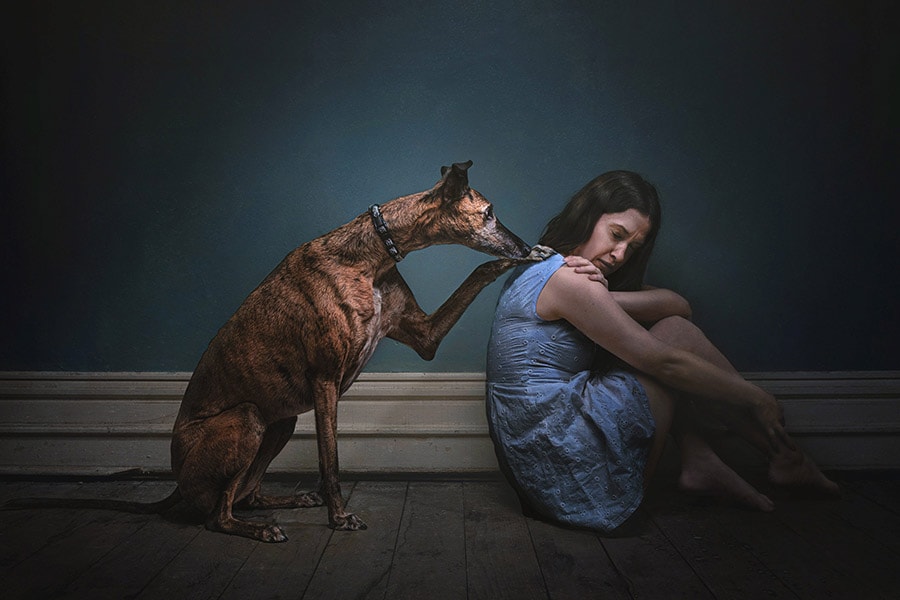
Quote from Tim Flach
“This is about how humans engage with content. We need arts that work on the subconscious, the subliminal. If something is thrust upon us, we often repel it, even if we make all the noises that we understand. We don’t take it to heart and the challenge is how you connect people.
If you bring personality and character to animals, so they’re almost in a style more associated culturally with human representation, then these images are going to connect to people more powerfully. The idea of taking animals and separating them, concentrating on them as subjects and as individuals with personality, and the importance of empathy.
There are a lot of indications that when we look at something we think is cute, we’re more likely to respond to cuteness before we have rational thought. It’s like a neural highway: you react so quickly before you even think about it.
If you want to communicate with people who are non-believers, the best way to tell a story is to have them connect with it first.
I started to try and blend Chris Knights Low Key portraits with Tim Flachs emotional connection. This is when my style started to really show, and my images started to connect with more people.
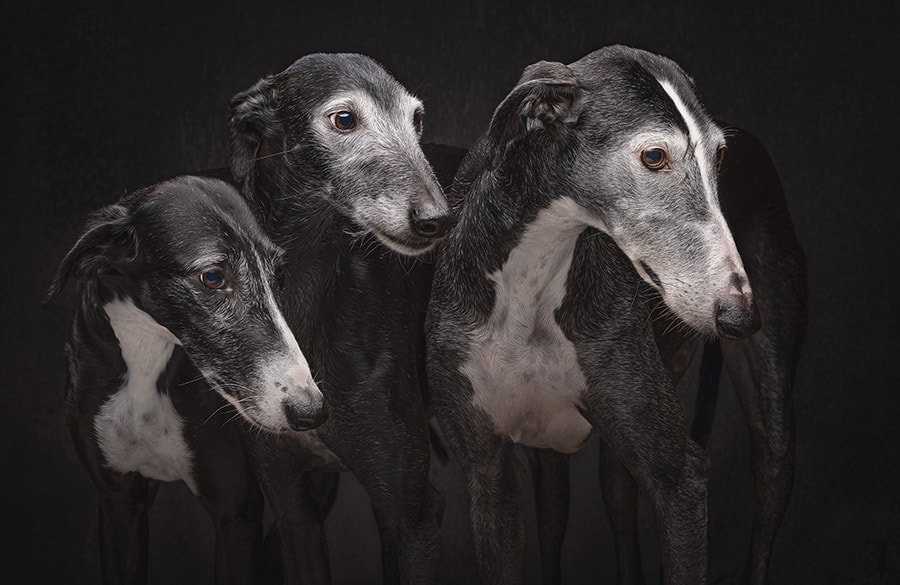
The Plight of Spain’s Hunting Dogs
Your commitment to the hunting dogs of Spain is evident not just in your photographs but in your activism. Can you share the story behind this passion and how it intertwines with your photography?
After adopting Leena, and seeing how traumatized she was, we needed to know more about her past and the life of the hunting dogs of Spain.
Galgo Espanol’s (Spanish greyhounds) are mainly used for hunting or coursing hare. During the annual hunting season that runs from October to January, many live in deplorable dark sheds when they are not coursing, spending their days confined and neglected. Training techniques are barbaric and include towing Galgo’s from cars, trucks, and motorcycles at 30mph for 15-20 miles.
Known as Galgueros, hunters dispose of Galgos at the end of hunting season in the most horrific ways imaginable… hung from trees, thrown into wells, starved, beaten to death, or abandoned. It is estimated that tens of thousands of Galgos are killed every year.
A favorite among hunters to dispose of unwanted Galgos is called “piano playing”. The galgo is tied around the neck and hung in a tree so that the poor dog barely reaches the ground with its hind paws, trying to balance and “dancing” back and forth with the back legs and paws, barely on the ground, to avoid strangulation. Being killed in this way is a slow death and that the dog experiences panic, anxiety, despair and unimaginable pain. The suffocation can take hours and sometimes even days. In the end, when the Galgo can no longer manage to stand on its hind legs, exhausted in the snare, the dog finally suffocates to death.
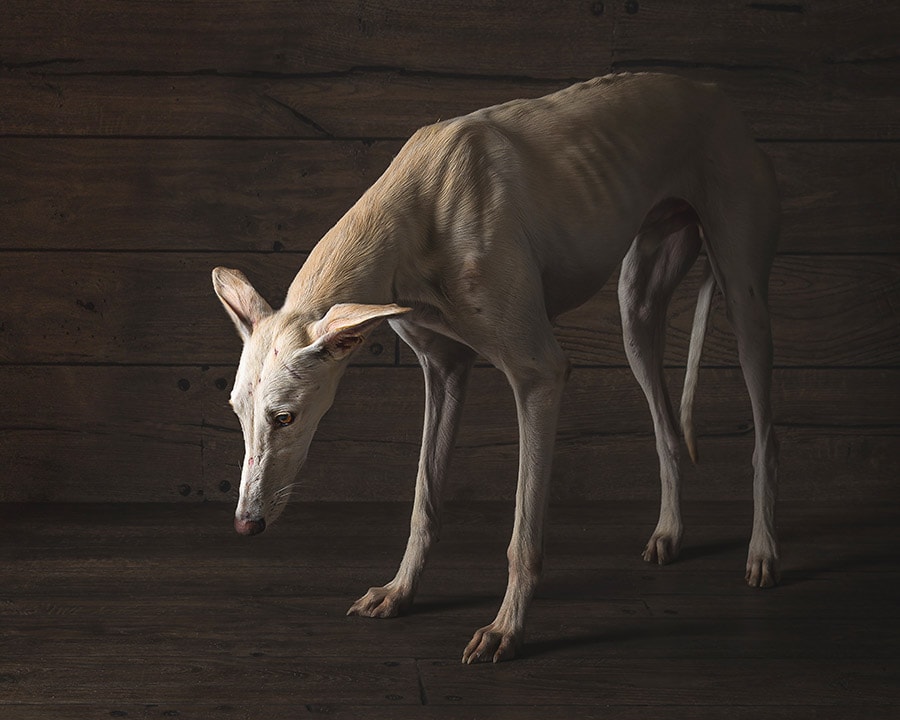
If merely abandoned, they are purposely hobbled so that they cannot physically return to the hunter. Those that survive abandonment languish in state-run shelters where they inevitably die.
The excessive, uncontrolled breeding and mass abandonment of dogs at the end of hunting season leaves a massive population of starving and sick dogs.
Associations in Spain, rescue and rehabilitate as many dogs as possible so that they have a chance at a future and a forever home. The Galgo is a truly precious and noble breed. Although not considered pets by Galgueros, they are wonderful companions, affectionate and eternally grateful for a second chance.
When I was first starting in photography, I was told “Shoot what you are passionate about, and it will show through in your images”. My Passion is for telling the story of the Hunting Dogs of Spain. During a trip to Spain to volunteer at a shelter, I took a photo of a very scared black galgo who was covered in scares and very thin. When I showed people the photo, I saw their reaction to the photo and how they felt the dogs fear, and it evoked empathy for the dog in the image. That is when I realized I could use photography to tell the story of the hunting dogs of Spain.
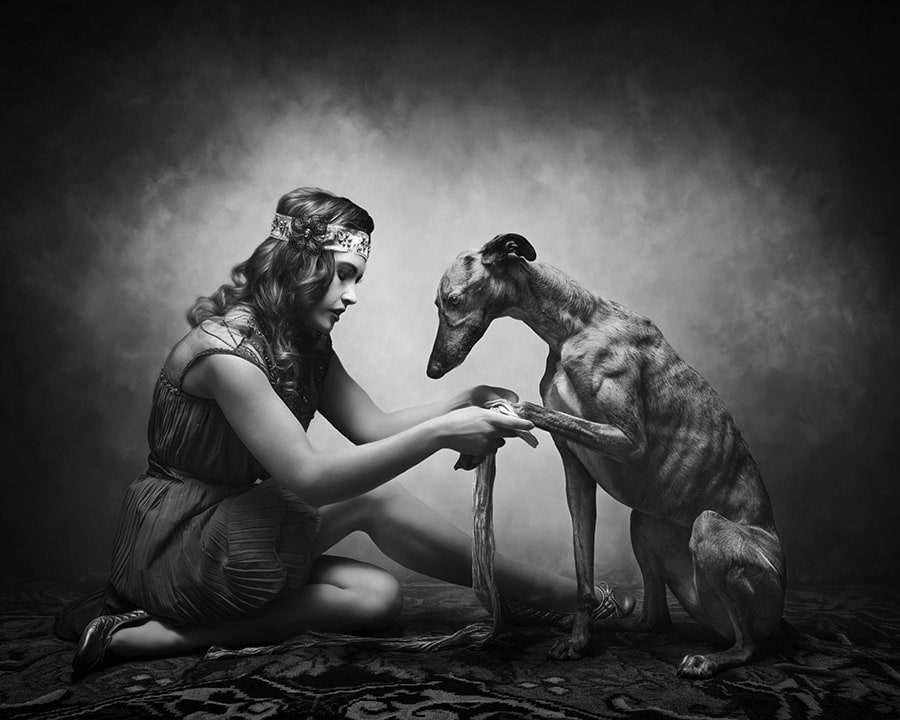
Accolades and Advocacy
Having been recognized as the Portrait Masters Awards Grand Champion and the Photographer of the Year in the reFocus Awards, what do these accolades mean to you, and how have they influenced your journey?
Getting recognized as the Portrait Masters Awards Grand Champion and Photographer of the Year in the reFocus Awards means a lot to me, and it’s had a big impact on my photography journey. I started entering print competitions because I wanted to get better at taking pictures, and the feedback from judges was super helpful. It didn’t take long for my photography skills to improve, and seeing all the amazing images from others inspired me to keep going.
In my first year at the Professional Photographers of America Imaging USA, I got nominated for two Grand Imaging Awards and even snagged third place in the Pets category. Plus, one of my photos made it to the cover of Professional Photographers Magazine in February 2019. But what really mattered to me was that these achievements allowed me to share the story of the hunting dogs of Spain with a much larger audience.
After a couple of years, something special happened during a live judging session. One of my photos featured a dog from Spain, and the judges started asking questions about it. Some of them even recognized it as a Galgo from Spain. That was way more meaningful to me than any score or ranking—it showed that my mission to raise awareness about these dogs was working, and more people were learning about their situation.
All of this has opened up some cool new opportunities for me. I gave my first talk at the Animal Image Makers Conference in April, and in January 2024, I’ll be speaking at PPA Imaging about Photo-Activism and how I use my pictures to shine a light on the hunting Dogs of Spain. These awards have not only boosted my photography skills but also given me a chance to make a real difference through my images.
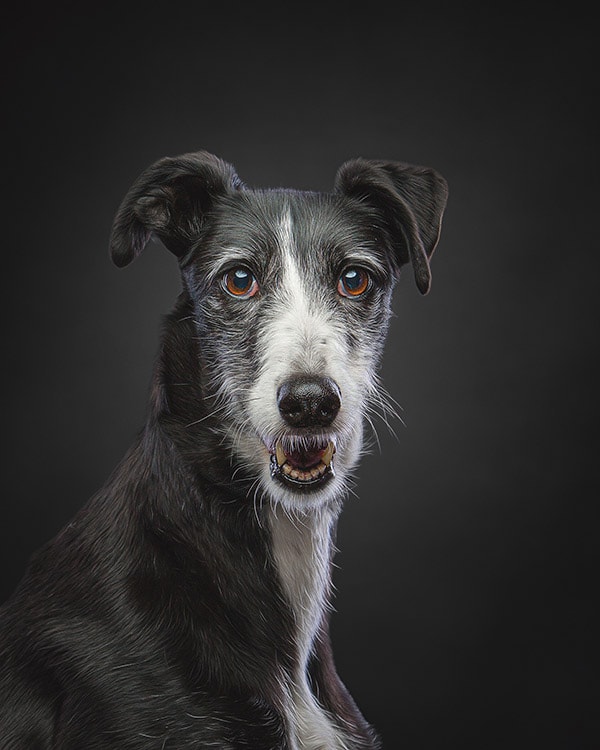
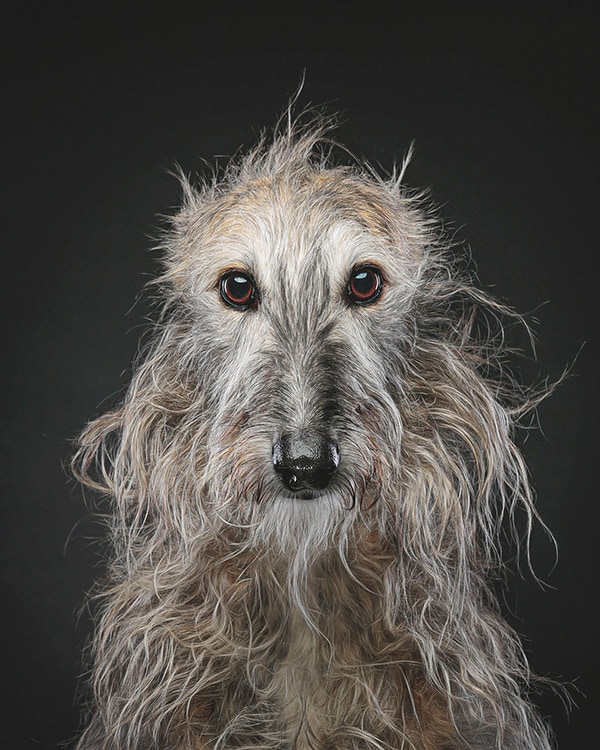
A Picture Worth a Thousand Emotions
Your portraits are known to evoke strong emotional connections. Can you share a particular project or image that holds a special place in your heart and the story behind it?
One image that holds an incredibly special place in my heart is “Saying Goodbye.” This image is deeply personal and meaningful to me as it serves as a tribute to Leena, a Spanish Greyhound who played a pivotal role in my life.
Back in October 2012, I was grappling with a profound and dark depression that led me to a very grim moment when I contemplated taking my own life. Thankfully, I had a moment of clarity and managed to prevent myself from going through with it. Just a week later, my wife and I made the decision to adopt a frightened Spanish Greyhound. Her previous owner had intended to hang her in a tree, deeming her no longer useful. The cruel irony of this situation was not lost on me.
I dedicated months to helping Leena regain her trust in people, and during this time, my depression faded into the background. In essence, she saved my life. Tragically, she passed away in April 2015. Whenever I find myself slipping into darkness, I think of her, and I can almost feel her presence beside me, offering comfort and solace. It was in her memory and with immense gratitude that I created the image “Saying Goodbye” to honor her.
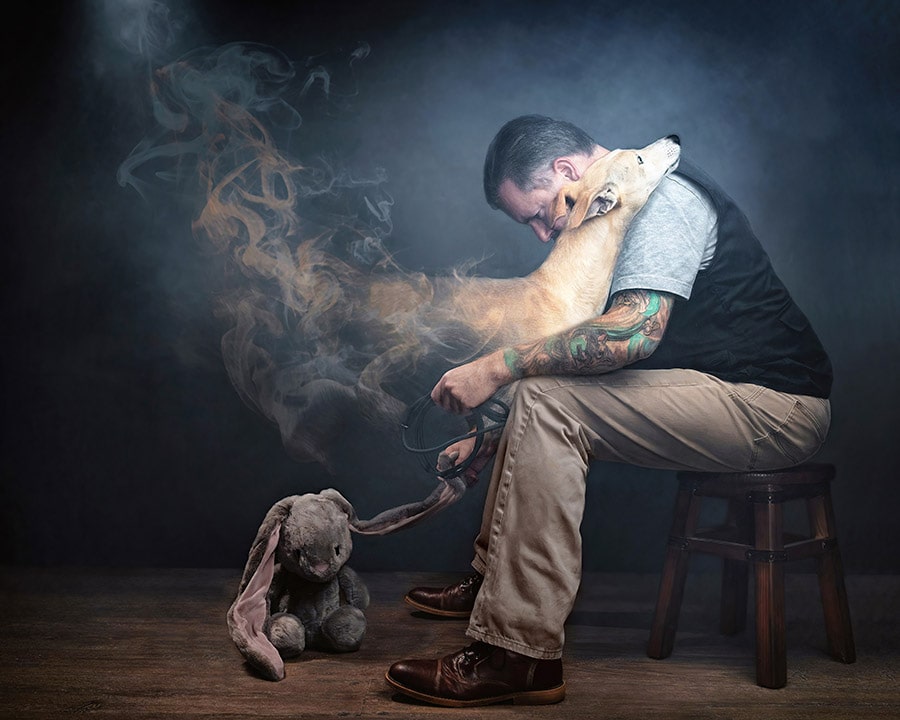
Leena’s impact on my life was profound. She is the reason my wife and I decided to establish an adoption group for the Hunting Dogs of Spain. When I bid farewell to Leena, I made a solemn promise to be a voice for her and all the other Hunting Dogs of Spain. In August 2014, I purchased my first DSLR camera with the explicit goal of using photography to tell the story of these remarkable dogs and to share how I see them through my eyes. Leena gave me a newfound voice through photography, and my ultimate mission is to share her story with as many people as possible.
Crafting the Perfect Studio Shot
Your portfolio is renowned for its detailed studio portraits, capturing the essence of each subject with precision. How do you craft the perfect studio environment for each shoot, and what elements do you believe are essential for a successful studio portrait?
Creating the ideal studio environment for my shoots, particularly with dogs as subjects, is a crucial aspect of achieving successful studio portraits. The primary focus is on ensuring the dog’s comfort and relaxation, as this directly impacts the quality of the photos.
To begin, I prioritize making the dog as comfortable as possible. If the dog exhibits stress, fear, or disinterest, it becomes challenging to capture good photographs. Upon the arrival of the dog(s) at the studio, I grant them the freedom to explore their surroundings, allowing them to become familiar with the studio environment. If, after approximately 45 minutes, the dogs still appear uneasy, I recommend a short break outside to destress before returning to the studio for further exploration.
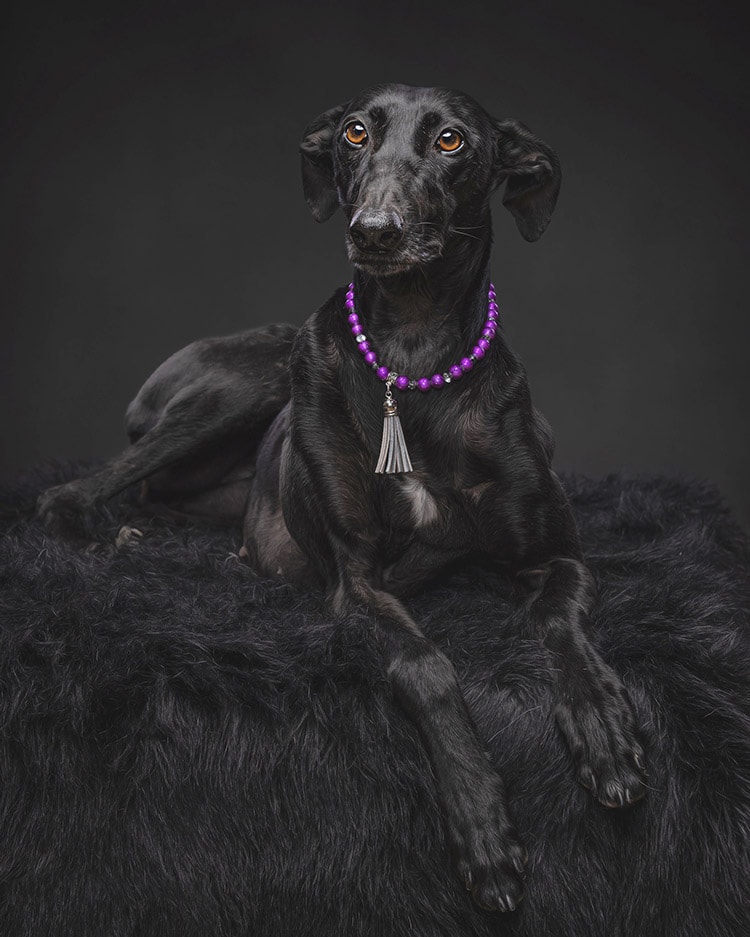
Once the dogs are more at ease, I introduce them to the studio strobes. To foster positive associations, I have the owner provide treats while I trigger the flash. This process is repeated multiple times, helping the dogs connect the flash with positive experiences. If a dog reacts negatively to the flash, I adjust the lighting by reducing the power to assess if it improves their comfort.
A fundamental skill for any animal photographer is the ability to read the body language of the subjects. This skill not only helps the dog become more relaxed in the studio but also enables me to capture images that showcase their genuine, happy, and engaged expressions. There have been instances where I’ve had limited success, capturing only two photos during a session. In one particular case, the dog initially displayed a slight reaction to the flash in the first shot and eventually jumped off the platform, seeking refuge behind the backdrop. Despite the challenges, these two photos turned out to be perfect, emphasizing the importance of patience and understanding in crafting successful studio portraits.
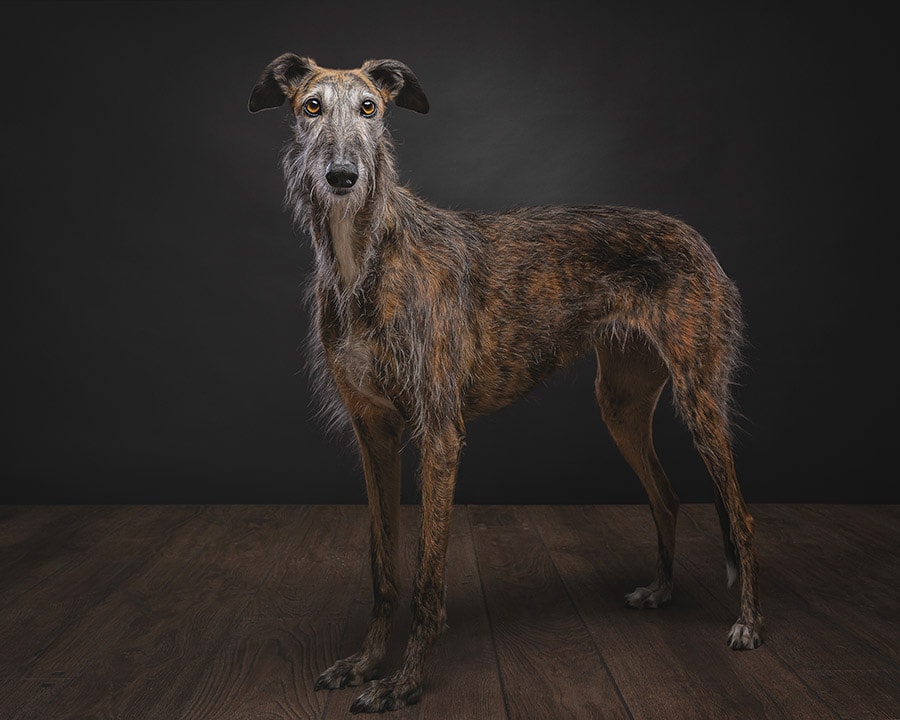
Behind the Scenes: Post-Production and Gear
Your studio shots are not only technically impeccable but also artistically profound. Beyond the camera, could you share insights into your post-production process? What are your favorite lenses, how many lights do you use, and what tools or software do you rely on to bring your vision to life?
One of my primary goals with my images has been to achieve a level of detail reminiscent of shots captured with a medium format camera. Additionally, I’ve learned the importance of guiding viewers’ eyes to specific areas within my images by utilizing contrast, sharpness, and opacity. It took some time and experimentation to refine these aspects in both my photography and post-processing techniques.
A significant breakthrough for me was the creation of a Photoshop action that outlines my post-processing workflow for each image I edit. This action serves as a step-by-step guide, ensuring consistency in my editing process and preventing me from overlooking any critical adjustments. This development has played a pivotal role in enhancing the quality of my images and maintaining a cohesive style throughout my work.
Most of my portrait work is accomplished with a Canon DSLR, although two years ago, I transitioned to a mirrorless Canon R5. My preferred lens is the Canon 70-200mm, with most portraits being captured at focal lengths between 105-135mm. This distance allows me to create a buffer between myself and the subject, which is particularly crucial when working with dogs that are often apprehensive around unfamiliar individuals, especially men. This approach minimizes their stress and helps establish a sense of comfort during the photography session. However, when photographing a dog that is already familiar with me, such as one of my fosters, I opt for a closer approach using a 24-70mm lens, positioning myself behind the camera for a more intimate connection.
For lighting, I will use one light and up to five lights depending on how I want the image to look or the story I’m trying to tell with the image. I like to play with different lighting setups from fashion and wedding photographers and recreate it with dogs. I also like to learn from product photography, I feel this is the best way to learn to control lighting.
In terms of post-processing, I employ Lightroom as a cataloging tool and conduct the majority of my editing tasks within Photoshop, which accounts for approximately 95% of my editing process.
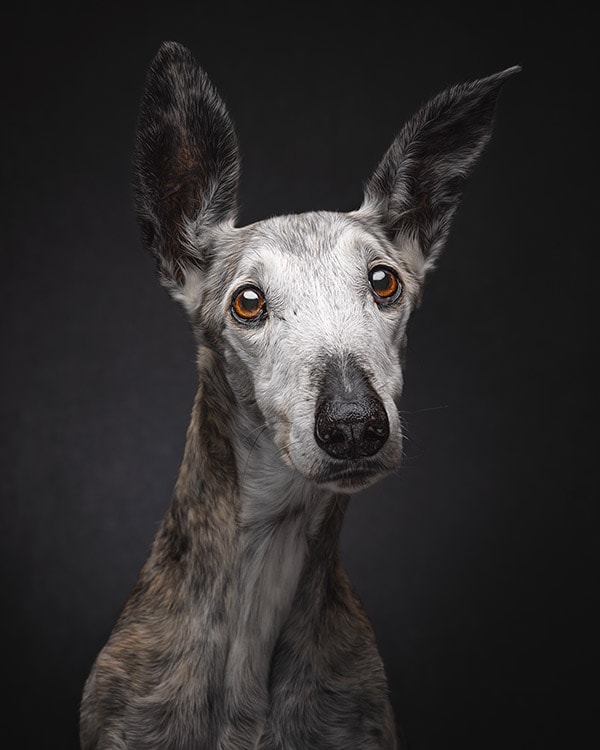
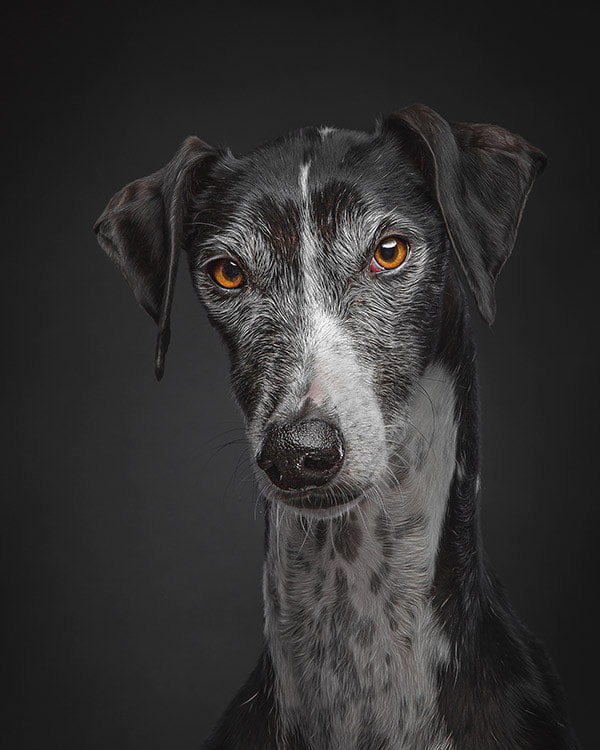
Advice for Aspiring Dog Photographers
For photographers inspired by your work and looking to specialize in dog photography, especially in a studio environment, what advice would you offer to help them establish themselves in this niche?
The world of dog photography, it’s the language of their bodies that tells the story. Capturing the perfect shot of a dog isn’t just about good lighting and a steady hand; it’s about understanding and interpreting their body language.
First and foremost, knowing how to read a dog’s body language is a matter of safety, both for the photographer and the dog. Dogs communicate their feelings and intentions through subtle cues in their posture, expression, and movement. Recognizing signs of stress, fear, or aggression can help a photographer avoid potentially dangerous situations during a photoshoot.
Every dog has a unique story, and it’s our job to tell it through images. Dog body language is the storyteller, conveying their personality, quirks, and the special bond they share with their human companions.
Also However, as with any medium, it is important for photographers to adhere to a code of ethics to ensure that their work is responsible and respectful.
First and foremost, it is important to respect the privacy and rights of their subjects. When working in shelters or with rescue organizations, this means obtaining consent from individuals before photographing them and ensuring that their privacy is not violated in any way. It is also important to be aware of and respect cultural sensitivities and customs.
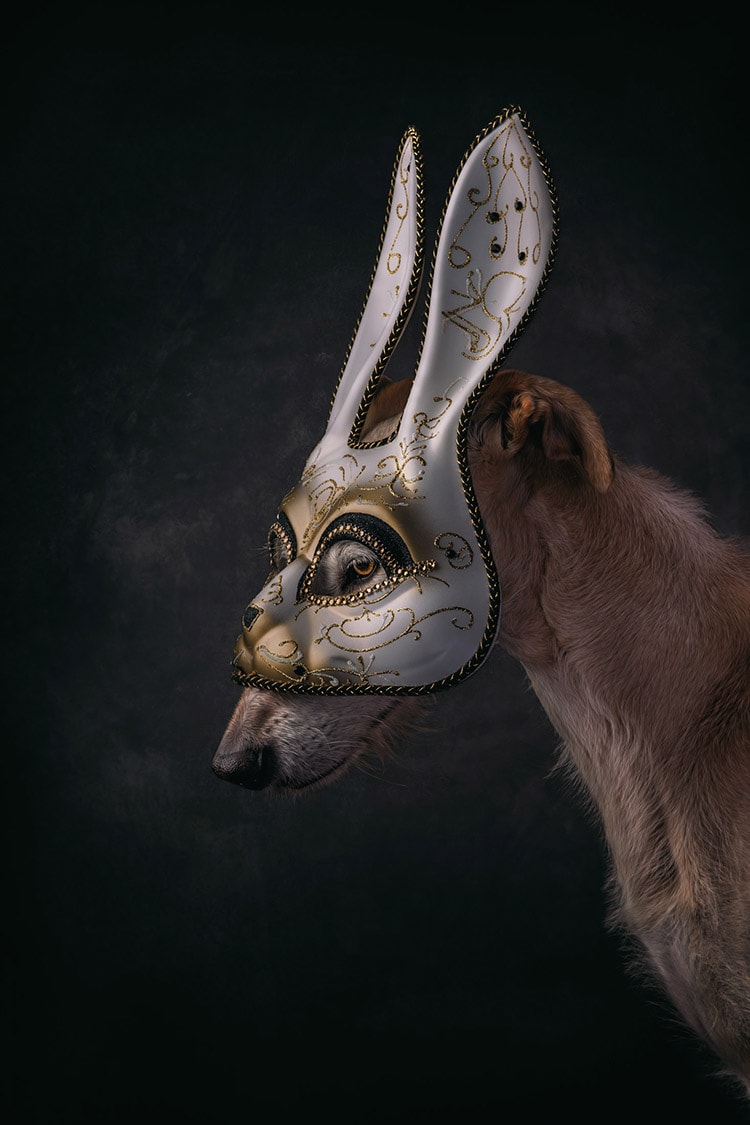
Another important aspect is the accurate representation of the subject matter. Photographers should avoid manipulating images in a way that misrepresents the reality of the situation. It is also important to be truthful in the captions and descriptions that accompany the photographs.
Furthermore, it is important to be aware of the potential impact of the photographs. You should consider the potential consequences of publishing certain photographs and avoid publishing images that could put individuals or rescue organizations at risk.
It’s also important to be aware of the potential for exploitation. We should avoid exploiting our subjects for personal gain and should avoid profiting from the sale of photographs that depict animals, or individuals in vulnerable situations.
Finally, we should be aware of the power of our images and use them responsibly. We should use our images to raise awareness and inspire change, rather than to exploit or sensationalize a situation.
Remember that animal photo-activism is a powerful tool for promoting animal welfare, but it requires patience, dedication, and a commitment to making a difference. Start small and work your way up, and you will soon see the impact of your efforts.
I hope this helps you to start to think more about your own photography and gets you thinking a little wider, a little deeper than just shooting for today to get a little bit of attention. What stories could you be capturing, what legacy could you be leaving, and what would you want them to say.
A New Perspective
Travis Patenaude’s journey is a powerful reminder of the transformative power of passion and purpose. His dedication to the hunting dogs of Spain and his unique approach to photography have not only raised awareness but also inspired countless individuals.
For those moved by Travis’s story and keen to explore the world of photography, remember that every great photographer started with a single shot. Whether you’re an animal lover, an aspiring photographer, or someone looking to capture the beauty around you, our photography courses in London (Wimbledon Art Studios) can help you embark on your own journey. Dive into the world of photography with us, and let your passion shine through every click.
